technical data JEEP RENEGADE 2014 1.G Owners Manual
[x] Cancel search | Manufacturer: JEEP, Model Year: 2014, Model line: RENEGADE, Model: JEEP RENEGADE 2014 1.GPages: 212, PDF Size: 17.48 MB
Page 3 of 212
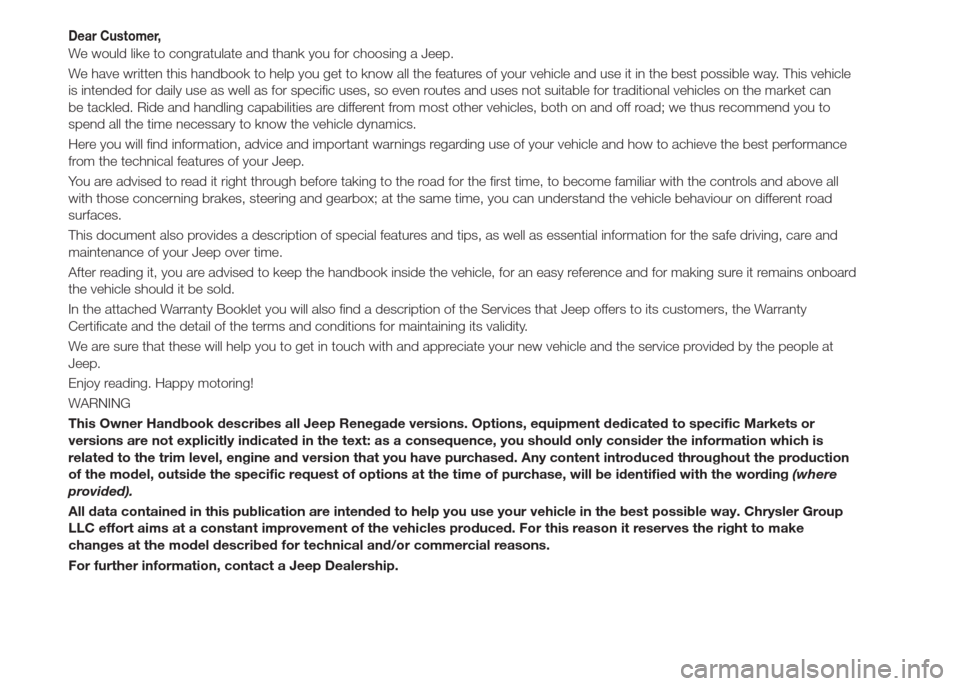
Dear Customer,
We would like to congratulate and thank you for choosing a Jeep.
We have written this handbook to help you get to know all the features of your vehicle and use it in the best possible way. This vehicle
is intended for daily use as well as for specific uses, so even routes and uses not suitable for traditional vehicles on the market can
be tackled. Ride and handling capabilities are different from most other vehicles, both on and off road; we thus recommend you to
spend all the time necessary to know the vehicle dynamics.
Here you will find information, advice and important warnings regarding use of your vehicle and how to achieve the best performance
from the technical features of your Jeep.
You are advised to read it right through before taking to the road for the first time, to become familiar with the controls and above all
with those concerning brakes, steering and gearbox; at the same time, you can understand the vehicle behaviour on different road
surfaces.
This document also provides a description of special features and tips, as well as essential information for the safe driving, care and
maintenance of your Jeep over time.
After reading it, you are advised to keep the handbook inside the vehicle, for an easy reference and for making sure it remains onboard
the vehicle should it be sold.
In the attached Warranty Booklet you will also find a description of the Services that Jeep offers to its customers, the Warranty
Certificate and the detail of the terms and conditions for maintaining its validity.
We are sure that these will help you to get in touch with and appreciate your new vehicle and the service provided by the people at
Jeep.
Enjoy reading. Happy motoring!
WARNING
This Owner Handbook describes all Jeep Renegade versions. Options, equipment dedicated to specific Markets or
versions are not explicitly indicated in the text: as a consequence, you should only consider the information which is
related to the trim level, engine and version that you have purchased. Any content introduced throughout the production
of the model, outside the specific request of options at the time of purchase, will be identified with the wording(where
provided).
All data contained in this publication are intended to help you use your vehicle in the best possible way. Chrysler Group
LLC effort aims at a constant improvement of the vehicles produced. For this reason it reserves the right to make
changes at the model described for technical and/or commercial reasons.
For further information, contact a Jeep Dealership.
Page 49 of 212
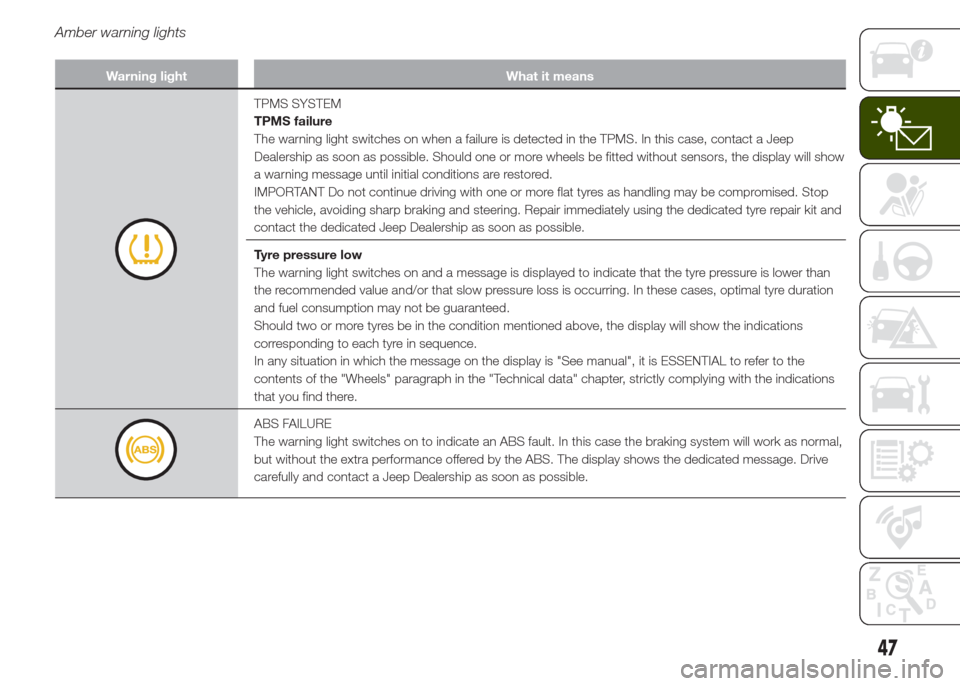
Amber warning lights
Warning light What it means
TPMS SYSTEM
TPMS failure
The warning light switches on when a failure is detected in the TPMS. In this case, contact a Jeep
Dealership as soon as possible. Should one or more wheels be fitted without sensors, the display will show
a warning message until initial conditions are restored.
IMPORTANT Do not continue driving with one or more flat tyres as handling may be compromised. Stop
the vehicle, avoiding sharp braking and steering. Repair immediately using the dedicated tyre repair kit and
contact the dedicated Jeep Dealership as soon as possible.
Tyre pressure low
The warning light switches on and a message is displayed to indicate that the tyre pressure is lower than
the recommended value and/or that slow pressure loss is occurring. In these cases, optimal tyre duration
and fuel consumption may not be guaranteed.
Should two or more tyres be in the condition mentioned above, the display will show the indications
corresponding to each tyre in sequence.
In any situation in which the message on the display is "See manual", it is ESSENTIAL to refer to the
contents of the "Wheels" paragraph in the "Technical data" chapter, strictly complying with the indications
that you find there.
ABS FAILURE
The warning light switches on to indicate an ABS fault. In this case the braking system will work as normal,
but without the extra performance offered by the ABS. The display shows the dedicated message. Drive
carefully and contact a Jeep Dealership as soon as possible.
47
Page 142 of 212
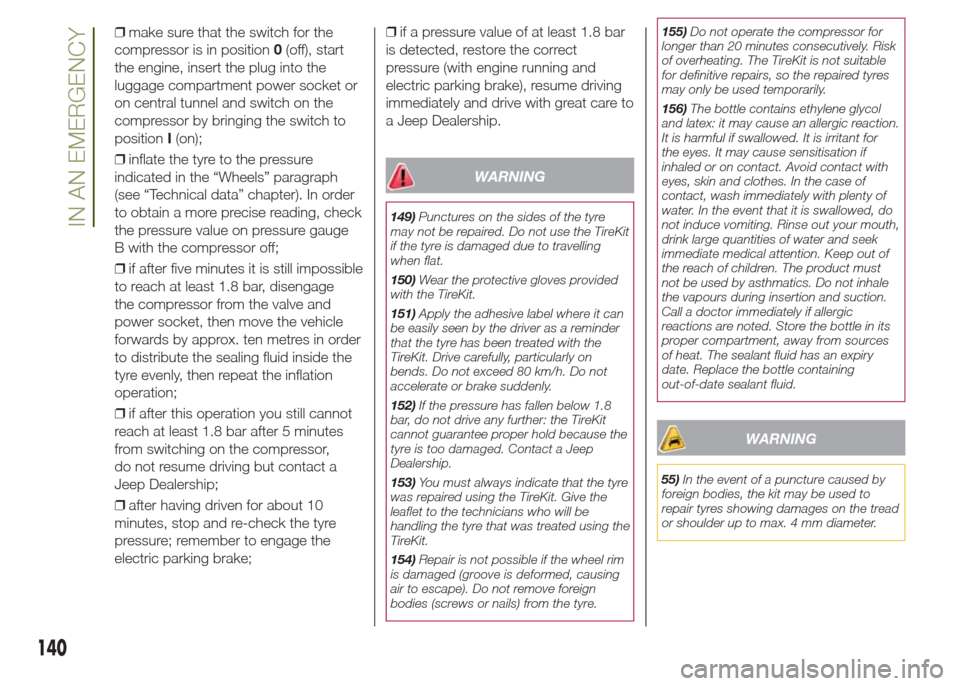
❒make sure that the switch for the
compressor is in position0(off), start
the engine, insert the plug into the
luggage compartment power socket or
on central tunnel and switch on the
compressor by bringing the switch to
positionI(on);
❒inflate the tyre to the pressure
indicated in the “Wheels” paragraph
(see “Technical data” chapter). In order
to obtain a more precise reading, check
the pressure value on pressure gauge
B with the compressor off;
❒if after five minutes it is still impossible
to reach at least 1.8 bar, disengage
the compressor from the valve and
power socket, then move the vehicle
forwards by approx. ten metres in order
to distribute the sealing fluid inside the
tyre evenly, then repeat the inflation
operation;
❒if after this operation you still cannot
reach at least 1.8 bar after 5 minutes
from switching on the compressor,
do not resume driving but contact a
Jeep Dealership;
❒after having driven for about 10
minutes, stop and re-check the tyre
pressure; remember to engage the
electric parking brake;❒if a pressure value of at least 1.8 bar
is detected, restore the correct
pressure (with engine running and
electric parking brake), resume driving
immediately and drive with great care to
a Jeep Dealership.
WARNING
149)Punctures on the sides of the tyre
may not be repaired. Do not use the TireKit
if the tyre is damaged due to travelling
when flat.
150)Wear the protective gloves provided
with the TireKit.
151)Apply the adhesive label where it can
be easily seen by the driver as a reminder
that the tyre has been treated with the
TireKit. Drive carefully, particularly on
bends. Do not exceed 80 km/h. Do not
accelerate or brake suddenly.
152)If the pressure has fallen below 1.8
bar, do not drive any further: the TireKit
cannot guarantee proper hold because the
tyre is too damaged. Contact a Jeep
Dealership.
153)You must always indicate that the tyre
was repaired using the TireKit. Give the
leaflet to the technicians who will be
handling the tyre that was treated using the
TireKit.
154)Repair is not possible if the wheel rim
is damaged (groove is deformed, causing
air to escape). Do not remove foreign
bodies (screws or nails) from the tyre.155)Do not operate the compressor for
longer than 20 minutes consecutively. Risk
of overheating. The TireKit is not suitable
for definitive repairs, so the repaired tyres
may only be used temporarily.
156)The bottle contains ethylene glycol
and latex: it may cause an allergic reaction.
It is harmful if swallowed. It is irritant for
the eyes. It may cause sensitisation if
inhaled or on contact. Avoid contact with
eyes, skin and clothes. In the case of
contact, wash immediately with plenty of
water. In the event that it is swallowed, do
not induce vomiting. Rinse out your mouth,
drink large quantities of water and seek
immediate medical attention. Keep out of
the reach of children. The product must
not be used by asthmatics. Do not inhale
the vapours during insertion and suction.
Call a doctor immediately if allergic
reactions are noted. Store the bottle in its
proper compartment, away from sources
of heat. The sealant fluid has an expiry
date. Replace the bottle containing
out-of-date sealant fluid.
WARNING
55)In the event of a puncture caused by
foreign bodies, the kit may be used to
repair tyres showing damages on the tread
or shoulder up to max. 4 mm diameter.
140
IN AN EMERGENCY
Page 167 of 212
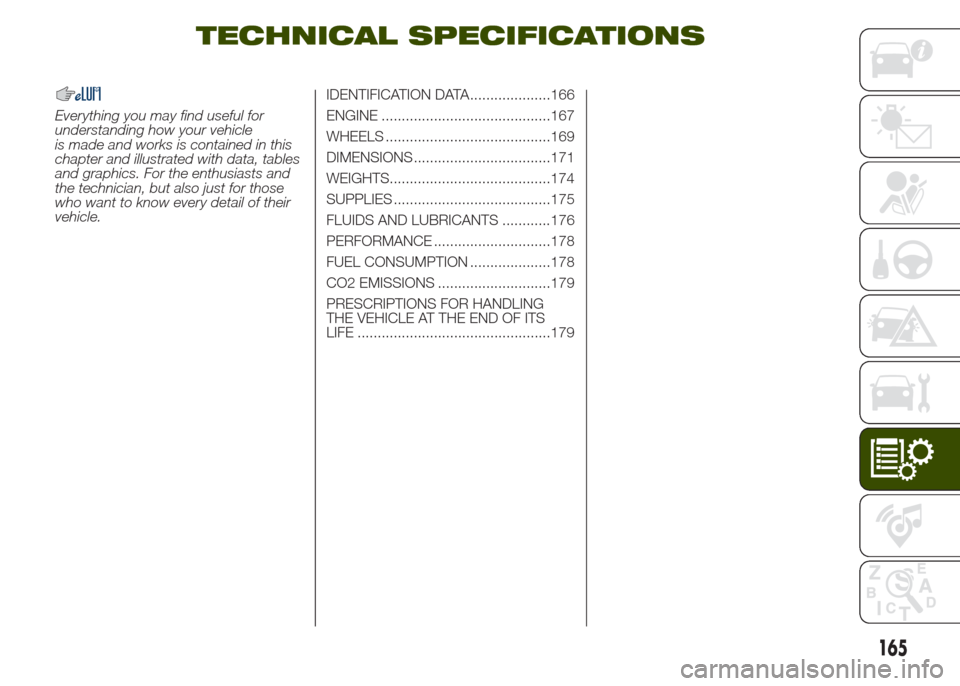
TECHNICAL SPECIFICATIONS
Everything you may find useful for
understanding how your vehicle
is made and works is contained in this
chapter and illustrated with data, tables
and graphics. For the enthusiasts and
the technician, but also just for those
who want to know every detail of their
vehicle.IDENTIFICATION DATA....................166
ENGINE ..........................................167
WHEELS .........................................169
DIMENSIONS ..................................171
WEIGHTS........................................174
SUPPLIES .......................................175
FLUIDS AND LUBRICANTS ............176
PERFORMANCE .............................178
FUEL CONSUMPTION ....................178
CO2 EMISSIONS ............................179
PRESCRIPTIONS FOR HANDLING
THE VEHICLE AT THE END OF ITS
LIFE ................................................179
165
Page 168 of 212
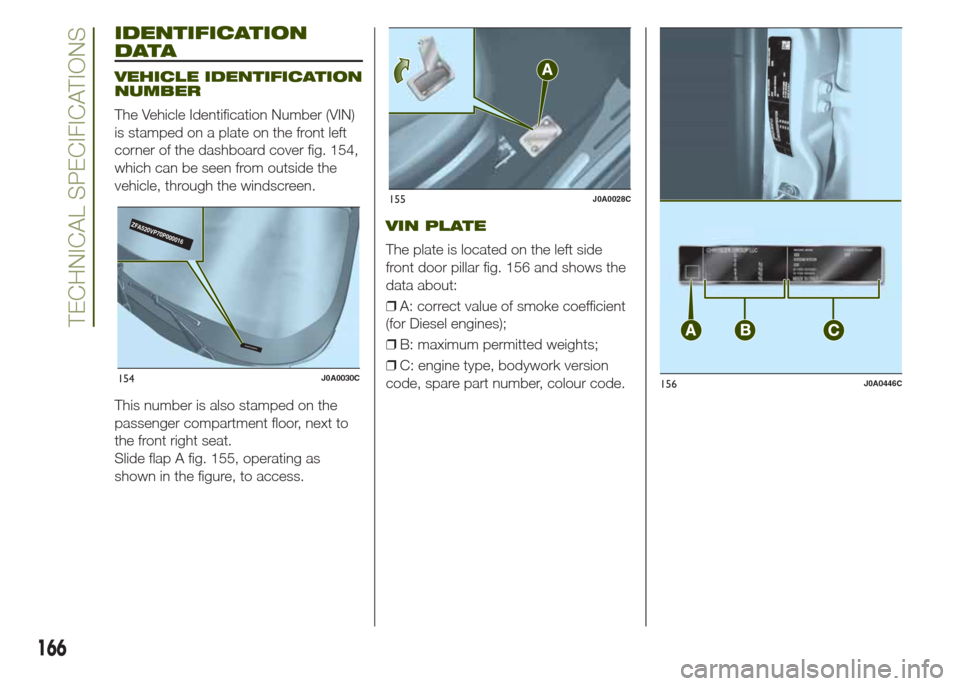
IDENTIFICATION
DATA
VEHICLE IDENTIFICATION
NUMBER
The Vehicle Identification Number (VIN)
is stamped on a plate on the front left
corner of the dashboard cover fig. 154,
which can be seen from outside the
vehicle, through the windscreen.
This number is also stamped on the
passenger compartment floor, next to
the front right seat.
Slide flap A fig. 155, operating as
shown in the figure, to access.
VIN PLATE
The plate is located on the left side
front door pillar fig. 156 and shows the
data about:
❒A: correct value of smoke coefficient
(for Diesel engines);
❒B: maximum permitted weights;
❒C: engine type, bodywork version
code, spare part number, colour code.
Z
FA520VP70P000016
ZFA520VP70P000016
154J0A0030C
155J0A0028C
156J0A0446C
166
TECHNICAL SPECIFICATIONS